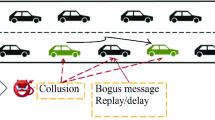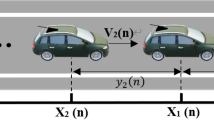Abstract
As traffic systems are becoming increasingly interconnected and automated, it is crucial to protect important systems from cyberattacks nowadays. In this study, we propose the Self-Stabilizing Cyberattack (SS-CA) model to investigate the connection between self-stabilizing control and the impact of cyberattacks on traffic flow dynamics in the context of connected vehicles. The linear stability analysis examines the stability criteria for the SS-CA model. Nonlinear analysis uses reductive perturbation methods to derive soliton solutions, providing descriptions of traffic density wave propagation. From the findings, it is evident that, as a cyberattack’s intensity increases, traffic stability decreases while increasing the self-stabilization control parameter enhances traffic stability. Furthermore, the effect of self-stabilizing control over headway is found effective in avoiding the negative impact of cyberattacks, which decreases traffic flow stability. The study validates theoretical insights through numerical simulations demonstrating the significance of self-stabilizing behavior in mitigating traffic disruptions caused by cyberattacks.









Similar content being viewed by others
Data Availability Statement
This is a theoretical study, hence there are no experimental data offered.
References
Y. Jiang, T. Ren, Y. Ma, Y. Wu, Z. Yao, Traffic safety evaluation of mixed traffic flow considering the maximum platoon size of connected automated vehicles. Phys. A Stat. Mech. Appl. 612, 128452 (2023)
J. Zeng, Y. Qian, J. Li, Y. Zhang, D. Xu, Congestion and energy consumption of heterogeneous traffic flow mixed with intelligent connected vehicles and platoons. Phys. A Stat. Mech. Appl. 609, 128331 (2023)
P. Bharti, K. Redhu, Kumar, Short-term traffic flow prediction based on optimized deep learning neural network: Pso-bi-lstm. Phys. A Stat. Mech. Appl. 625, 129001 (2023)
Y. Yang, X. Han, R. Jiang, B. Jia, Z.Y. Gao, Competition and coordination in public transport: a mode choice experiment. Transp. Res. Part C Emerg. Technol. 143, 103858 (2022)
M. Pham, K. Xiong, A survey on security attacks and defense techniques for connected and autonomous vehicles. Comput. Security 109, 102269 (2021)
X. Wang, R. Jiang, L. Li, Y.L. Lin, F.Y. Wang, Long memory is important: a test study on deep-learning based car-following model. Phys. A Stat. Mech. Appl. 514, 786–795 (2019)
Y.M. Yuan, R. Jiang, M.B. Hu, Q.S. Wu, R. Wang, Traffic flow characteristics in a mixed traffic system consisting of acc vehicles and manual vehicles: a hybrid modeling approach. Phys. A Stat. Mech. Appl. 388(12), 2483–2491 (2009)
J. Zhao, F. Xu, W. Liu, J. Bai, X. Luo, Travel time prediction based on pattern matching method. Int. J. Smart Sens. Intell. Syst. 8(1) (2015)
T.Q. Tang, W.F. Shi, H.J. Huang, W.X. Wu, Z. Song, A route-based traffic flow model accounting for interruption factors. Phys. A Stat. Mech. Appl. 514, 767–785 (2019)
S. Yadav, P. Redhu, Bifurcation analysis of driver’s characteristics in car-following model. J. Comput. Nonlinear Dyn., pp. 1–12 (2023)
M. Verma, S. Sharma, Modeling heterogeneity in an open percolation backbone fractal traffic network. Phys. A Stat. Mech. Appl. 619, 128721 (2023)
P. Redhu, A.K. Gupta, Jamming transitions and the effect of interruption probability in a lattice traffic flow model with passing. Phys. A Stat. Mech. Appl. 421, 249–260 (2015)
P. Redhu, A.K. Gupta, Effect of forward looking sites on a multi-phase lattice hydrodynamic model. Phys. A Stat. Mech. Appl. 445, 150–160 (2016)
A.K. Gupta, P. Redhu, Analyzes of driver’s anticipation effect in sensing relative flux in a new lattice model for two-lane traffic system. Phys. A Stat. Mech. Appl. 392(22), 5622–5632 (2013)
A.K. Gupta, P. Redhu, Jamming transition of a two-dimensional traffic dynamics with consideration of optimal current difference. Phys. Lett. A 377(34–36), 2027–2033 (2013)
P. Redhu, A.K. Gupta, Phase transition in a two-dimensional triangular flow with consideration of optimal current difference effect. Nonlinear Dyn. 78, 957–968 (2014)
N. Madaan, S. Sharma, A lattice model accounting for multi-lane traffic system. Phys. A Stat. Mech. Appl. 564, 125446 (2021)
S. Sharma, Lattice hydrodynamic modeling of two-lane traffic flow with timid and aggressive driving behavior. Phys. A Stat. Mech. Appl. 421, 401–411 (2015)
P. Redhu, V. Siwach, An extended lattice model accounting for traffic jerk. Phys. A Stat. Mech. Appl. 492, 1473–1480 (2018)
S.P. Hoogendoorn, P.H. Bovy, Generic gas-kinetic traffic systems modeling with applications to vehicular traffic flow. Transp. Res. Part B Methodol. 35(4), 317–336 (2001)
C. Tampère, B. Van Arem, S. Hoogendoorn, Gas-kinetic traffic flow modeling including continuous driver behavior models. Transp. Res. Record 1852(1), 231–238 (2003)
S. Mahajan, D. Kumar, A.K. Verma, N. Sharma, Dynamic Analysis of Modified SEIR Epidemic Model with Time Delay in Geographical Networks (Statistical Mechanics and its Applications, Physica A, 2023), p.129191
S. Tamizhazhagan, A.K. Verma, Reentrance transition in two lane bidirectional transport system with bottlenecks. Chaos Solitons Fractals 165, 112780 (2022)
R. Jiang, Q.S. Wu, The traffic flow controlled by the traffic lights in the speed gradient continuum model. Phys. A Stat. Mech. Appl. 355(2–4), 551–564 (2005)
R. Jiang, Q.S. Wu, Z.J. Zhu, A new continuum model for traffic flow and numerical tests. Transp. Res. Part B Methodol. 36(5), 405–419 (2002)
G.H. Peng, X. Cai, C. Liu, B. Cao, M. Tuo, Optimal velocity difference model for a car-following theory. Phys. Lett. A 375(45), 3973–3977 (2011)
J. Zhang, T.Q. Tang, S.W. Yu, An improved car-following model accounting for the preceding car’s taillight. Phys. A Stat. Mech. Appl. 492, 1831–1837 (2018)
G.H. Peng, A new car-following model with driver’s anticipation effect of traffic interruption probability. Chinese Phys. B 29(8), 084501 (2020)
X. Li, Y. Zhou, G. Peng, Impact of interruption probability of the current optimal velocity on traffic stability for car-following model. Int. J. Mod. Phys. C 33(03), 2250041 (2022)
G.H. Peng, T.T. Jia, H. Kuang, H.L. Tan, T. Chen, A novel car-following model by sharing cooperative information transmission delayed effect under v2x environment and its additional energy consumption. Chinese Phys. B 31(5), 058901 (2022)
T.Q. Tang, Y. Gui, J. Zhang, T. Wang, Car-following model based on deep learning and Markov theory. J. Transp. Eng. Part A Syst. 146(9), 04020104 (2020)
L. Peng, T.Q. Tang, T. Wang, J. Zhang, A car-following model accounting for the driving habits. Phys. A Stat. Mech. Appl. 525, 108–118 (2019)
O. Hui, T.Q. Tang, J. Zhang, J.M. Zhou, A car-following model accounting for probability distribution. Phys. A Stat. Mech. Appl. 505, 105–113 (2018)
X.G. Li, B. Jia, Z.Y. Gao, R. Jiang, A realistic two-lane cellular automata traffic model considering aggressive lane-changing behavior of fast vehicle. Phys. A Stat. Mech. Appl. 367, 479–486 (2006)
X. Li, Q. Wu, R. Jiang, Cellular automaton model considering the velocity effect of a car on the successive car. Phys. Rev. E 64(6), 066128 (2001)
M. Bando, K. Hasebe, A. Nakayama, A. Shibata, Y. Sugiyama, Dynamical model of traffic congestion and numerical simulation. Phys. Rev. E 51(2), 1035 (1995)
D. Helbing, B. Tilch, Generalized force model of traffic dynamics. Phys. Rev. E 58(1), 133 (1998)
R. Jiang, Q. Wu, Z. Zhu, Full velocity difference model for a car-following theory. Phys. Rev. E 64(1), 017101 (2001)
T.Q. Tang, C.Y. Li, H. Huang, A new car-following model with the consideration of the driver’s forecast effect. Phys. Lett. A 374(38), 3951–3956 (2010)
G.H. Peng, R.J. Cheng, A new car-following model with the consideration of anticipation optimal velocity. Phys. A Stat. Mech. Appl. 392(17), 3563–3569 (2013)
T.Q. Tang, J. He, S.C. Yang, H.Y. Shang, A car-following model accounting for the driver’s attribution. Phys. A Stat. Mech. Appl. 413, 583–591 (2014)
H. Ou, T.Q. Tang, An extended two-lane car-following model accounting for inter-vehicle communication. Phys. A Stat. Mech. Appl. 495, 260–268 (2018)
S. Li, T. Wang, R. Cheng, H. Ge, An extended car-following model considering the driver’s desire for smooth driving and self-stabilizing control with velocity uncertainty. Math. Prob. Eng. 2020, 1–17 (2020)
B. Yu, H. Zhou, L. Wang, Z. Wang, S. Cui, An extended two-lane car-following model considering the influence of heterogeneous speed information on drivers with different characteristics under honk environment. Phys. A Stat. Mech. Appl. 578, 126022 (2021)
S. Yadav, P. Redhu, Driver’s attention effect in car-following model with passing under V2V environment. Nonlinear Dyn. 111, 13245–13261 (2023)
S. Yadav, V. Siwach, P. Redhu, Impact of driver’s advanced reaction time in car-following model with optimal velocity deviation under V2X environment. Europhys. Lett. 143, 52004 (2023)
G.H. Peng, D.H. Sun, A dynamical model of car-following with the consideration of the multiple information of preceding cars. Phys. Lett. A 374(15–16), 1694–1698 (2010)
G.H. Peng, C.L. Luo, H.Z. Zhao, H.L. Tan, A novel lattice model integrating the cooperative deviation of density and optimal flux under V2X environment. Chinese Phys. B 32(1), 018902 (2023)
Z. Li, W. Li, S. Xu, Y. Qian, Analyzes of vehicle’s self-stabilizing effect in an extended optimal velocity model by utilizing historical velocity in an environment of intelligent transportation system. Nonlinear Dyn. 80, 529–540 (2015)
J. Wang, F. Sun, R. Cheng, H. Ge, An extended car-following model considering the self-stabilizing driving behavior of headway. Phys. A Stat. Mech. Appl. 507, 347–357 (2018)
J. Reilly, S. Martin, M. Payer, A.M. Bayen, Creating complex congestion patterns via multi-objective optimal freeway traffic control with application to cyber-security. Transp. Res. Part B Methodol. 91, 366–382 (2016)
S. Dadras, R. M. Gerdes, R. Sharma, Vehicular platooning in an adversarial environment. In: Proceedings of the 10th ACM Symposium on Information, Computer and Communications Security, pp. 167–178 (2015)
R. M. Gerdes, C. Winstead, K. Heaslip, Cps: an efficiency-motivated attack against autonomous vehicular transportation. In: Proceedings of the 29th Annual Computer Security Applications Conference, pp. 99–108 (2013)
C. Zhai, W. Wu, Designing continuous delay feedback control for lattice hydrodynamic model under cyber-attacks and connected vehicle environment. Commun. Nonlinear Sci. Numer. Simul. 95, 105667 (2021)
G.H. Peng, T. Jia, H. Zhao, H. Tan, Integrating the historical evolution information integral effect in car-following model under the V2X environment. Phys. A Stat. Mech. Appl. 627, 129125 (2023)
X. Yu, Analysis of the stability and density waves for traffic flow. Chinese Phys. 11(11), 1128 (2002)
Acknowledgements
The first author(Sunita Yadav) would like to show appreciation to the “Council of Scientific and Industrial Research (CSIR)” in New Delhi, India for their funding support through file number 09/382(0245)/2019-EMR-I.
Funding
Funding was provided by Human Resource Development Group.
Author information
Authors and Affiliations
Contributions
PR supervised the work while SY provided the concept and worked on the simulation, analysis, and idea implementation. Both SY and PR 4contributed to the writing of the manuscript.
Corresponding author
Ethics declarations
Conflict of interest
The authors have confirmed that they do not have any conflicting interests related to the work.
Rights and permissions
Springer Nature or its licensor (e.g. a society or other partner) holds exclusive rights to this article under a publishing agreement with the author(s) or other rightsholder(s); author self-archiving of the accepted manuscript version of this article is solely governed by the terms of such publishing agreement and applicable law.
About this article
Cite this article
Yadav, S., Redhu, P. Self-stabilization control on traffic flow of connected and automated vehicles under cyberattacks. Eur. Phys. J. Plus 138, 1160 (2023). https://doi.org/10.1140/epjp/s13360-023-04791-8
Received:
Accepted:
Published:
DOI: https://doi.org/10.1140/epjp/s13360-023-04791-8




